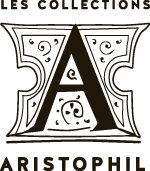Lot n° 58
Estimation :
10000 - 15000
EUR
Result with fees
Result
: 9 100EUR
COCTEAU JEAN (1889-1963).
MANUSCRIT autograph "Jean", Bacchus, Comédie dramatique en 3 actes, 1951; 259 pages various sizes, and 170 pages in-fol. and in-4, under two spiral-bound sketchbook covers.
Important set of preparatory studies and complete manuscript of Cocteau's most ambitious play Bacchus, which caused a scandal.
The play was written during 1951 and premiered on December 20, 1951 at the Théâtre Marigny by the Renaud-Barrault troupe, directed by Cocteau and Jean-Louis
Barrault, who played the role of Cardinal Zampi alongside Jean Desailly (Hans, the Bacchus), with sets and costumes by Cocteau himself.
Bacchus provoked a violent polemic between the Catholic
François Mauriac and Cocteau. Published in 1952 by Gallimard, Bacchus was dedicated to Francine Weisweiller.
"In a small German town, at the beginning of the 16th century, the arrival of an extraordinary envoy of the Holy See, Cardinal Zampi, who has come to investigate the actions of the Lutherans, coincides with the election of a "Bacchus", king of Carnival who, according to an ancient tradition, enjoys absolute power for a week. The chosen one is a young peasant who passes for an idiot. He is in fact, under this mask, a kind of idealistic anarchist who wants to make love reign. His attitude generates a fierce hatred which threatens him with the stake. The cardinal, moved by his sincerity, tries to save him, by proposing him to enter the orders. What
Hans refuses. An arrow sent by the son of the duke, who had become his friend, saved him in extremis from the torment of fire" (Jacques Brosse). For Cocteau, Bacchus was "a play with ideas. (The opposite of a play with thesis)".
The manuscript is presented in the form of two large sets, each with a spiral-bound sketchbook cover.
A. "Studies for Bacchus". Drafts, sketches and preparatory notes, in all 259 pages.
Important set of disparate sheets, both in terms of media (writing paper, drawing paper, cardboard, letter pad covers, envelopes, etc.), formats (from large in-fol. to in-8, edges chipped to some very large ff. ), the tools (blue or blue-black ink, red or blue ballpoint pen, pencil...), as well as the content of these pages: lines to be inserted, sketches of scenes, dialogues, drafts of scenes, documentary notes, drawings, etc. One notices in particular: "Scène finale du 3e acte" (1 f. grand in-fol. blue ink; on the back, large pencil drawing (face with geometrical forms). * "Conduite de l'acte III en très gros" (3 ff. in-4 in pencil); on the versos, three portraits of Jean Marais in pencil. * "Scène acte I" (1 f. in-4 in red ballpoint pen, notes for 2 scenes of act I); on verso, pencil portrait of Jean
Marais. * Fragment of a scene between the duke and the bishop (2 ff. in-fol., red ballpoint pen). * Draft of a scene of Christine (1 f. in-fol. in pencil). * "First draft of the scene of Hans and the cardinal" (11 ff. in-fol., red ballpoint pen). * "Scène du Cardinal et d'Ulrich acte II" (1 p. in-4 in pencil; on verso, pencil drawing: pillory scene). * "Scène Évêque-Ulrich, acte 2" (10 ff. in-8 in pencil).
* "act 2 scene Ulrich the Cardinal" (9 ff. in-4 in pencil). * "before the original sin" (1 p. in-8 in blue ink). * Notes for a scene between
Bacchus and the Cardinal (6 ff. in-fol. blue pen). * Scene Cardinal-Ulrich (21 ff. in-4 or in-8, pencil). * "Scène évêque-Guillaume" (7 ff. in-4 in pencil). * Fragment of the Cardinal-Ulrich scene (1 f. in-4 in pencil); on the reverse, pencil portrait of Francine Weisweiller in profile. * Plan of the 2nd act (1 f. in-fol. blue pen); dialogue on verso * "Marche de la scène Hans le cardinal" (1 p. in-8 blue ink). * "Sketch of the 1st scene" (13 ff. in-4, blue ink, pag. 1-12). * Draft of Act I, scene 2 (9 ff. in-4, blue ink, pag. 1-9). * "Studies for Act II" (12 ff. in-4, blue ink and pencil, corresponding to scene 8 of Act II). * "Christine-Ulrich" scene fragment (1 f. in-4, pencil); on verso, pencil portrait of Édouard Dermit sleeping. * "Premier brouillon de la scène du conseil des édiles" (47 f. in-4, pencil and blue ink), also containing a draft of the "scène de l'interrogatoire" and one of the scene between the duke and the bishop. Etc.
The file on the Bacchus project is a good illustration of Cocteau's new working method, inspired by his work as a painter. All these fragments of scenes, tirelessly repeated, are as many layers that, like a painter, the playwright takes up one after the other. The scattered sheets, on which sometimes only one or two lines are found, are like the first strokes of a pencil. Among a hundred examples, we can note this dialogue: "- He is a moron. - No, an idiot. - It's the same thing.
My orders
Sale information
Sales conditions
Return to catalogue

